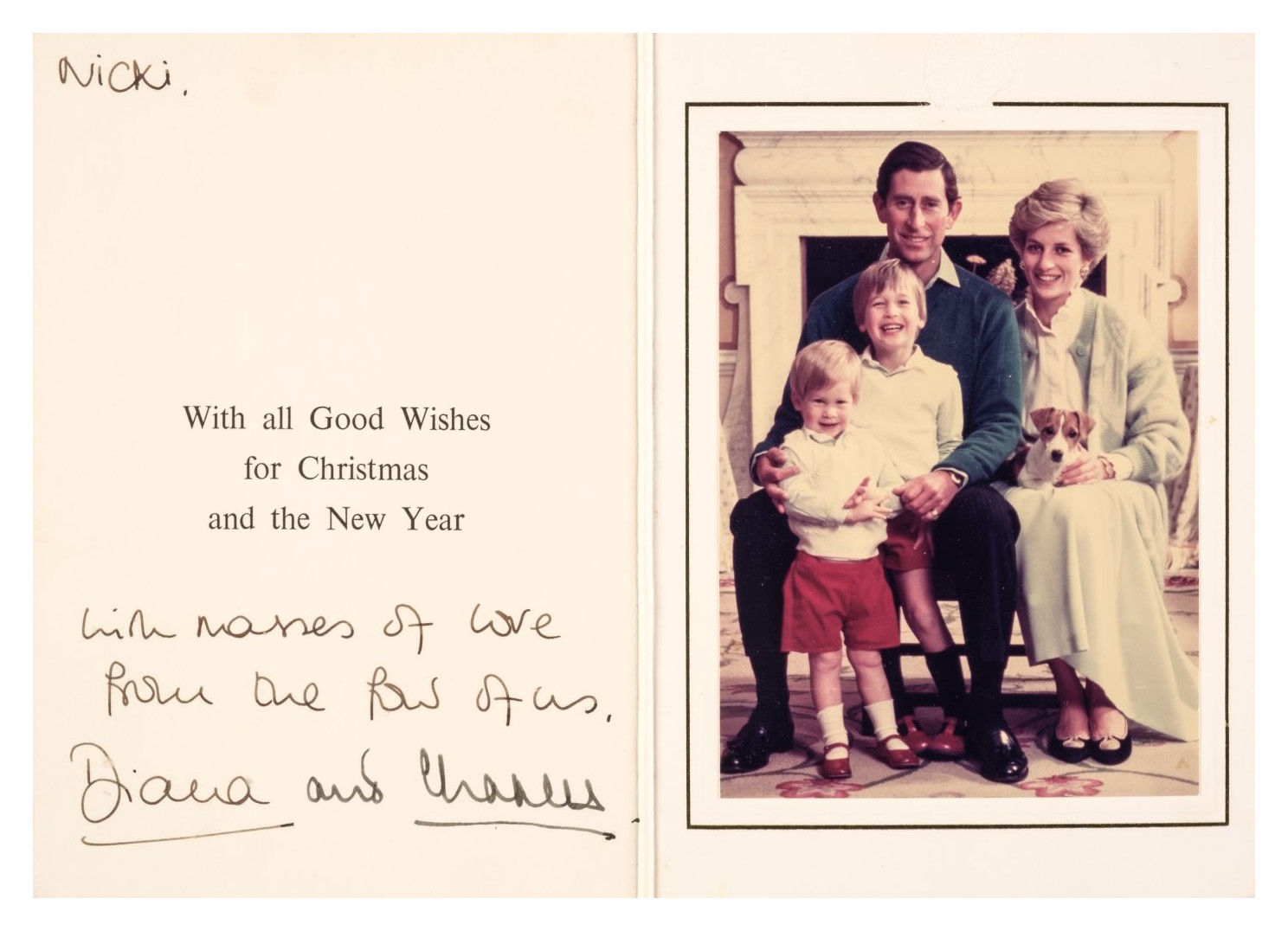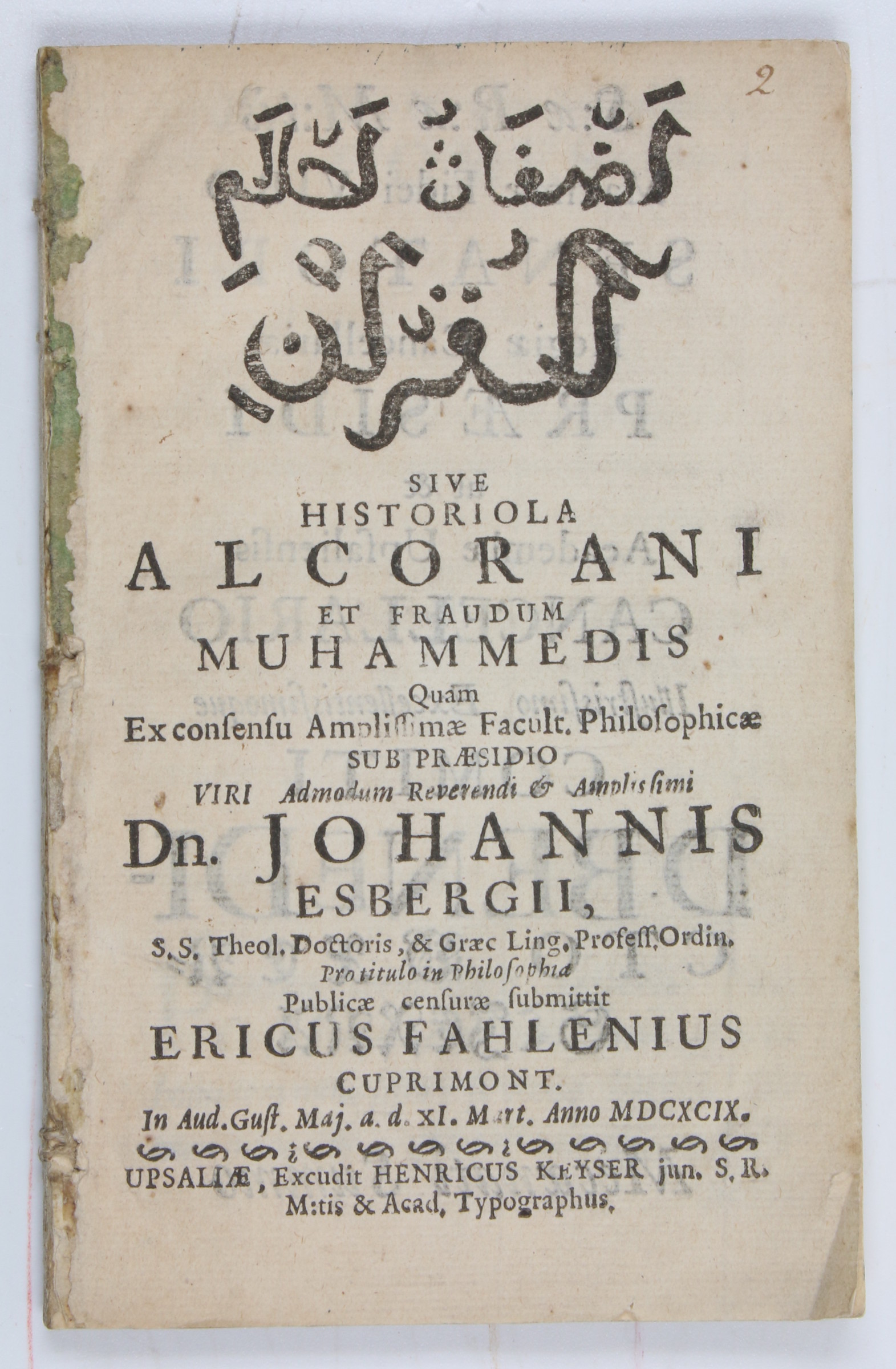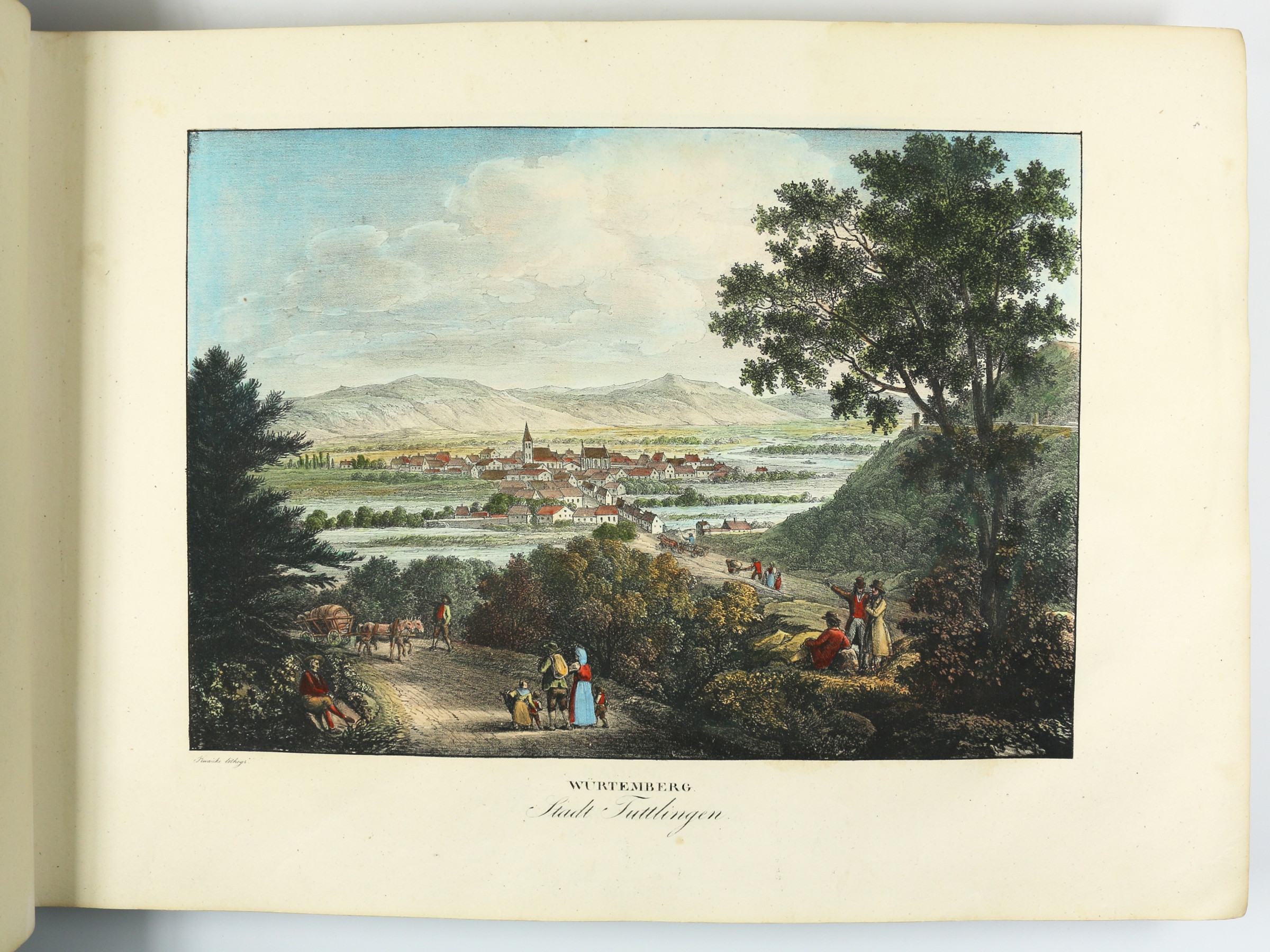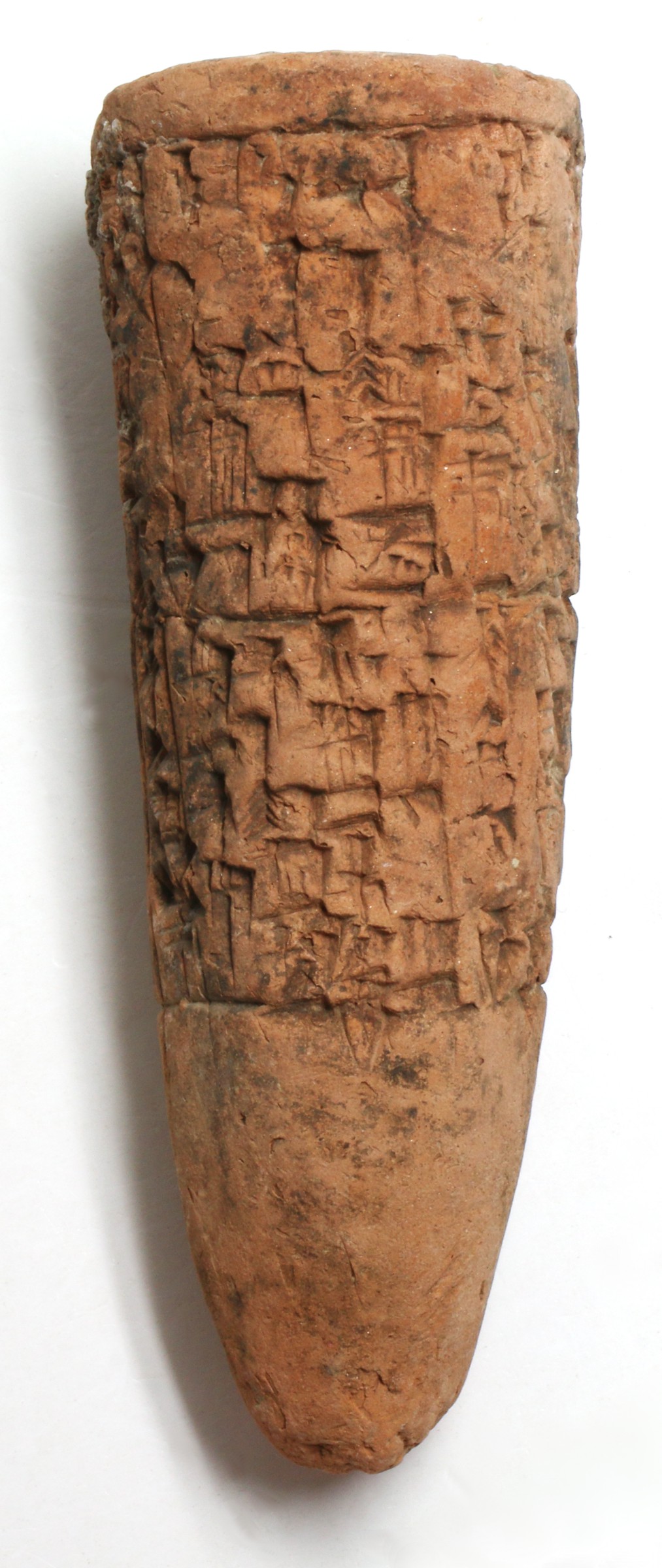
Inscribed by Diana for Nicki: "With masses of love from the four of us". Signed by Diana and Charles in their respective hands. Opposite, a mounted colour photograph of the seated Prince and Princess of Wales with the young Princes William and Harry in red shorts, a Jack Russell dog on Diana's lap.
Faint spot near the name "Nicki"; paper surface loss to upper margin above photograph with small loss of gilt-ruled border, and further paper surface loss to margins of lower board (probably from previous mounting in an album).

A Sub-Saharan or Sudanese manuscript on the conquest of Africa through Uqba ibn Amir (d. 677/8 CE) under the reign of the Caliph Uthman (ca. 576-656 CE), closely based on the work by the Golden Age historian al-Waqidi (ca. 747-823 CE). While some passages are identical to al-Waqidi's history, other sections have been omitted and new information has been added, suggesting a work with several sources, among which Al-Waqidi is the predominant one.
The focus of this chronicle is important to the history both of Africa as well as of Islam: aside from their secular roles, Caliph Uthman and the conqueror Uqba ibn Amir were both companions of the Prophet Muhammad. Uthman ruled over the Rashidun Caliphate at the pinnacle of its power and expanse, including Mediterranean Africa and Nubia (today largely Sudan). It is particularly interesting that this is, as identified by its script and style, a sub-Saharan or Sudanese manuscript, an African manuscript on the history of Africa - though its main source, the historian Al-Waqidi, was a native of Medina. While largely based on and paraphrasing al-Waqidi's work, this manuscript is the only extant variant of "Futuh Ifriqiya" of its kind we have been able to identify, and may be a unique text.

Rare document issued during the Siege of Paris by the Ambulances de la Presse for a Parisian servant named Dufresne, accrediting him as a first responder and requesting free passage for him: "Laissez-Passer - Monsieur Dufresne, domestique, demeurant 7 Rue Greffhule [!] attaché aux Ambulances de la Presse, annexes du Ministère de la Guerre, pour relever les blessés sur le camp de bataille".
The Ambulances de la Presse were founded on an initiative of the French press in September 1870 after the collapse of the Second French Empire and would be active beyond the end of the war, until some weeks after the fall of the Paris Commune. The document was issued in the name of the general secretary of the Ambulances de la Presse, the famous journalist and editor at Le Figaro, Albert Dardenne de la Grangerie.
Stamped "Payé". Somewhat soiled and minor foxing, several minor tears and traces of folds.

Interesting document from the final years of Bernese rule in Vaud and Nyon, as highlighted by Bern's woodcut coat of arms at the head of the form. The passport was issued by M. Aneth, secretary to the bailiff of Nyon, in the name of Jean Gaudin, a young man from nearby Begnins who was travelling to Geneva and back. It includes a description of Gaudin's appearance, also mentioning the amount of money he was carrying. Gaudin's entering and departing from the canton of Geneva in Versoix were noted by two different magistrates, one entry dated 24 Ventôse II (14 February 1794).
While the Revolution had reached Geneva as early as 1792, with rather tumultous consequences, the Canton of Vaud would drive out the Bernese governor in 1798 (with the support of French troops), ending 360 years of foreign rule. The newly-declared Lemanic Republic would soon be incorporated as a canton to the Helvetic Republic (1798-1803).
Minor browning and mimal tears.
Rare, decorative manuscript map of the 1707 Siege of Toulon on the French Riviera during the War of the Spanish Succession. Carried out meticulously and in great detail, it features a lovely cartouche in the lower right corner. The map indicates the town and port of Toulon, the forts of Santa Catarina and Sainte-Marguerite, both briefly held by the Allies, the towns of La Valette-du-Var, Ardenes, and the hospital on Saint-Mandrier-sur-Mer, along with powder magazines and encampments against the rolling hinterlands.
A nearly identical map, signed by the Italian draughtsman T. Nicolotti (fl. 1701-07) and drawn as a trompe l'oeil inset within a larger map of the coast of France and Italy that showing the marches and camps of the Allied and French armies in 1707, is owned by the Royal Collection Trust (RCIN 725097). It differs from the present map merely in colouring and the arrangement of the legend text.
The siege of Toulon took place between 29 July and 21 August 1707, when a combined Savoyard-Imperial army, supported by a British naval force, attacked the French base at Toulon. The town successfully resisted the siege, while thousands of Allied troops were incapacitated by disease.
Two sections somewhat browned. Lower right corner of the backing board chipped, with slight loss to legend text. The pierced cardboard backing suggests that the map was once wall-mounted.

Rare user's guide for the Mineral Occurence Documentation System (MODS), a database constituting the main mineral information base of the Kingdom of Saudi Arabia. The personal copy of Dr. Soliman Mahmoud Soliman, professor of Geology in Qatar (and previously of Ain Shams University in Cairo), who published prolifically on topics related to oil prospecting; his ownership to front cover.
As stated in the introduction, the database was prepared by the French Bureau of Geological and Mining Research, a scientific institution also providing expertise and resources for mining operations. In French regions and abroad, BRGM, with its growing reputation as the subsurface specialist, was increasingly called upon. Their database aims to contain information related to every mineral and non-metallic reservoir located in the Kingdom of Saudi Arabia. Operating to this day, MODS provides detailed data on mineral resources and prospecting projects, including geochemical and geophysical surveys, geologic mapping, and drilling.

Rare scientific paper on the carboniferous rocks of northern, Egypt issued by Dr. Soliman Mahmoud Soliman, professor of Geology in Qatar (and previously of Ain Shams University in Cairo), who published prolifically on topics related to oil prospecting. After a thorough geological analysis revealing the absence of source rocks, the present paper concludes that the petroleum found in the carboniferous strata of oil fields in the Gulf of Suez province probably migrated from younger strata. Illustrated with detailed geological maps of northern Egypt.
Reprinted for private circulation from the American Association of Petroleum Geologists Bulletin, vol. 54, no. 10, October 1970.
In excellent condition.

Rare issue of the quarterly newsletter of the UNESCO Regional Office for Science and Technology in the Arab States (ROSTAS) based in Cairo. Printed entirely in Arabic, the bulletin includes a statement on the "Conference of Ministers of Arab States responsible for the Application of Science and Technology to Development", held in Rabat from 16 to 25 August 1976, as well as a report on the history and work of ROSTAS. With a quotation by the Muslim scholar Ibn Khaldun on rear wrappers, including an English translation by Franz Rosenthal.
Manuscript Arabic ownership to front cover. Small tears to spine. Otherwise in fine condition.

Branded rear-view mirror tag reminding the driver of regular engine lubrication and oil change, recommending General Petroleum products.
In excellent condition.

Advertising postcard promoting Egyptian General Petroleum lubricants, reminding drivers to take their car to the nearest service station. Although not primarily intended for postage, it is essentially a picture postcard complete with address field and stamp panel, handed out at filling stations and other points of sale as part of a General Petroleum promotion campaign.
In excellent condition.

A very early Swedish treatise on the Qur'an (and, careful not to appear too interested, on "Muhammad's deception"). The woodcut tailpiece is a Qur'anic verse (sura 56:79): "Let only the pure touch it" (known as the "nemo tangat nisi mundatus" formula in Latin), derived from Schickard's "Jus regium Hebraeorum" (Leipzig, 1674). "Koranic quotations in the work are in Hebrew characters, owing to the lack of Arabic types, as the author explains in an additionally printed preliminary leaf. On p. 48 the author prints a quotation from the Testamentum published by Nicelius in 1655" (Smitskamp).
The author, among his many pursuits, was a professor of Greek at Uppsala University, and later superintendent of Gotland. Johan Esberg (1665-1734) was theologically curious, and allegedly ran into some trouble with his Protestant university after it came to light that not only did he keep up a correspondence with the Pope, but Esberg had in fact once written to the Pope declaring he needed 300 scudi to pay off book purchases, for which he was willing to publicly convert to Catholicism. Esberg successfully argued to his employers that this had been carried out "in a delirium" and kept his position.
The respondent Erik Fahlen (d. 1710) was, similarly, Professor of Oriental Languages and Greek in Pernau.

A splendid set of views, probably the finest record ever published of the course of the Danube from its source to its outlet into the Black Sea. This is the only copy in contemporary colour known in the trade and in auction records of the last decades.
The Danube played a vital role in the settlement and political evolution of central and southeastern Europe. Its banks, lined with cities, castles and fortresses, formed the boundary between great empires, and its waters served as a vital commercial highway between nations. In the 21st century the river has continued its role as an important trade artery and is now a vital part of the New Silk Road project.
Contains views of Baden (nos. 1-3 & 5), Württemberg (nos. 4 & 6-11), Bavaria (nos. 12-48), Austria (nos. 49-123, 125), Hungary (126-157), and of the Balkan states and Turkey (nos. 158-264). Includes the complete text as well as the four-part, cloth-backed map. Complete copies are of the utmost rarity, and copies coloured throughout must be considered almost unobtainable. The auction records of the last 50 years list no more than six complete copies, of which this present one was the only one in original colour (Hartung & Hartung, Munich, sale 99 [2000], lot 787).
Site map for the First Pan-Arab Games, held in Alexandria in 1953. Assisting spectators in making their way around the Olympic site, the map details stadiums, sports clubs and racing grounds, along with schools, museums, and the British Consulate. The schedule on the reverse indicates buses and trams calling at the various competition venues, not failing to mention the events and sports to be witnessed there, including athletics, weightlifting, football, swimming, basketball, boxing, wrestling, and shooting, as well as the opening and closing ceremonies.
The Arab Games, formerly called the Pan-Arab Games, are a regional multi-sport event held between nations from the Arab world. They are organized by the Union of Arab National Olympic Committees and intended to be held every four years, though political turmoil as well as financial difficulties have made the event an unstable one.
A few minor tears. Generally well preserved.
First separate edition: legal treatise on the international status of Kuwait, Bahrain and Qatar, with particular respect to the British protectorate. Prepared by Issam Abdel Rahman Azzam, an expert on international and Middle Eastern law, drawing on his own master thesis of the same title.
The paper explains the constitutional system and structure of government of the three states, elaborates on matters of extraterritorial jurisdiction, and stresses the necessity of clear national boundaries, particularly since "oil discoveries and exploitations converted the unclaimed desert territories into valuable assets and the problem has taken on the form of territorial disputes between most of the states on the Persian Gulf" (p. 34).
Offprint from the "Revue Egyptienne de Droit International", no. 15. Slightly toned, otherwise very well preserved.
The last official report report on Mandate Palestine by the British Colonial Office, submitted annually to the League of Nations Mandates Commission, detailing the Arab Revolt of 1938. This final report was issued in the midst of the 1936-38 revolt against British colonial rule, and includes the Colonial Office's traditionally detailed records on the local economy, politics, judicial system, public health, and religion. Much additional attention is given, however, to British and League promotion of Zionist interests, and to a summary of the events and reprisals of the Revolt.
After the collapse of the Ottoman Empire following the close of the First World War, Ottoman territories were distributed as spoils of war amongst the victors (in practice, largely Britain and France). Britain's colonial office ruled the Mandate of Palestine in the name of the League of Nations, to whom it was required to submit this annual report. The first full report was made in 1924 and continued annually until 1938.

Foundation cone of light reddish clay with a flat base on the broadside and a rounded tip on the other side. The 18-line inscription, covering around two thirds of the cone, originates from Ishme-Dagan, the fourth king of the First Dynasty of Isin. He ruled over southern Mesopotamia. This foundation cone certifies that under his reign the city walls of Isin were fortified. The translation of the inscription reads: "When Ishme-Dagan, the mighty, king of the four world regions, abolished the taxes of Nippur, the city beloved of Enlil, and excused its men from military service, he built the great ramparts of Isin, and the name of that wall is Ishme-Dagan".
Used by Sumerians and other Mesopotamian cultures beginning in the third millennium BCE, foundation cones, also referred to as dedication or foundation pegs or nails, were cone-shaped nails made of clay, inscribed with cuneiform, baked, and stuck into the mudbrick walls to serve as evidence that the temple or building was the divine property of the god to whom it was dedicated.












